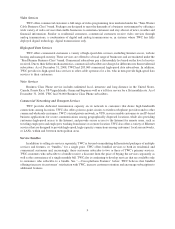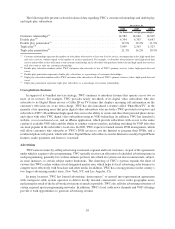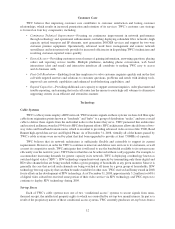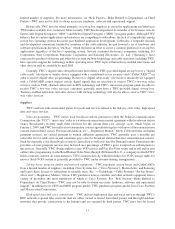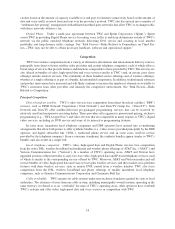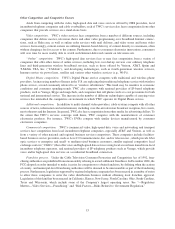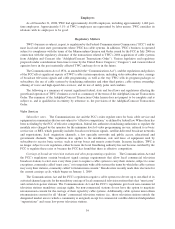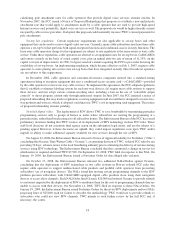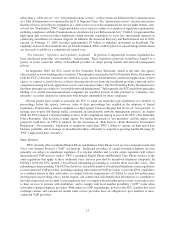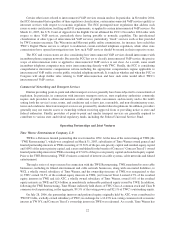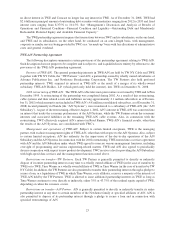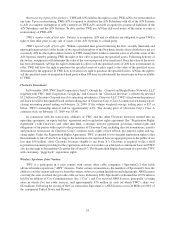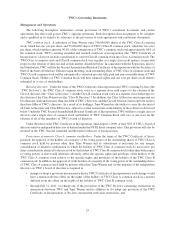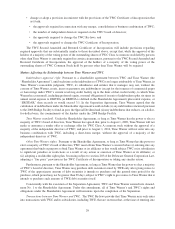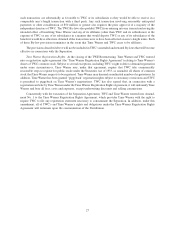Time Warner Cable 2008 Annual Report Download - page 28
Download and view the complete annual report
Please find page 28 of the 2008 Time Warner Cable annual report below. You can navigate through the pages in the report by either clicking on the pages listed below, or by using the keyword search tool below to find specific information within the annual report.calculating pole attachment rates for cable operators that provide digital voice services remains unclear. In
November 2007, the FCC issued a Notice of Proposed Rulemaking that proposes to establish a new unified pole
attachment rate that would apply to attachments made by a cable operator that are used to provide high-speed
Internet services and, potentially, digital voice services as well. The proposed rate would be higher than the current
rate paid by cable service providers. If adopted, this proposal could materially increase TWC’s current payments for
pole attachments.
Set-top box regulation. Certain regulatory requirements are also applicable to set-top boxes and other
equipment that can be used to receive digital video services. Currently, many cable subscribers rent from their cable
operator a set-top box that performs both signal-reception functions and conditional-access security functions. The
lease rates cable operators charge for this equipment are subject to rate regulation to the same extent as basic cable
service. Under these regulations, cable operators are allowed to set equipment rates for set-top boxes, CableCARDs
and remote controls on the basis of actual capital costs, plus an annual after-tax rate of return of 11.25%, on the
capital cost (net of depreciation). In 1996, Congress enacted a statute requiring the FCC to pass rules fostering the
availability of set-top boxes. An implementing regulation, which became effective on July 1, 2007, requires cable
operators to cease placing into service new set-top boxes that have integrated security. Direct broadcast operators
are not subject to this requirement.
In December 2002, cable operators and consumer-electronics companies entered into a standard-setting
agreement relating to reception equipment that uses a conditional-access security card—a CableCARD—provided
by the cable operator to receive one-way cable services. To implement the agreement, the FCC adopted regulations
that (i) establish a voluntary labeling system for such one-way devices; (ii) require most cable systems to support
these devices; and (iii) adopt various content-encoding rules, including a ban on the use of “selectable output
controls” to direct program content only through authorized outputs. In June 2007, the FCC initiated a notice of
proposed rulemaking that may lead to regulations covering equipment sold at retail that is designed to receive two-
way products and services, which, if adopted, could increase TWC’s cost in supporting such equipment. This notice
of proposed rulemaking remains pending.
Switched digital video. The deployment of SDV allows TWC to save bandwidth by transmitting particular
programming services only to groups of homes or nodes where subscribers are viewing the programming at a
particular time, rather than broadcasting it to all subscriber homes. The Enforcement Bureau of the FCC has issued
preliminary decisions finding that TWC’s notice of its deployment of SDV technology violates FCC rules. These
staff-level decisions do not constitute final agency action on the substantive legal issues, and are the subject of a
pending appeal. However, if these decisions are upheld, they could impose significant costs upon TWC and/or
impede its ability to make additional capacity available for new services through the use of SDV.
On August 22, 2008, the Enforcement Bureau released a Notice of Apparent Liability for Forfeiture (“NAL”)
concluding that Oceanic Time Warner Cable (“Oceanic”), an operating division of TWC, violated FCC rules by not
providing 30 days’ advance notice to the local franchising authority prior to initiating the delivery of certain existing
services using SDV technology. The Enforcement Bureau concluded that this constituted a change in service for
which notice is required and fined TWC $7,500. On September 22, 2008, TWC filed its response to this NAL. On
January 19, 2009, the Enforcement Bureau issued a Forfeiture Order for this alleged rule violation.
On October 15, 2008, the Enforcement Bureau released two additional NALs/Orders against Oceanic,
concluding that the deployment of SDV technology in two cable systems in Hawaii violated FCC rules that
require cable operators to support unidirectional cable products and prohibit cable operators from preventing
subscribers’ use of navigation devices. The NALs found that moving certain programming channels to the SDV
platform prevents subscribers with CableCARD-equipped digital cable products from using their navigation
devices to access those channels. Each NAL/Order fined Oceanic $20,000 and ordered Oceanic to provide refunds
to customers impacted by the deployment of SDV to reimburse them for the cost of programming channels they are
unable to access with their devices. On November 14, 2008, TWC filed its response to these NALs/Orders. On
January 19, 2009, the Enforcement Bureau issued Forfeiture Orders for these two SDV deployments and two NALs
proposing fines of $25,000 each for failure to describe the methodology TWC would use to provide refunds to
subscribers who could not view SDV channels. TWC intends to seek further review by the full FCC and, if
necessary, the courts.
18



